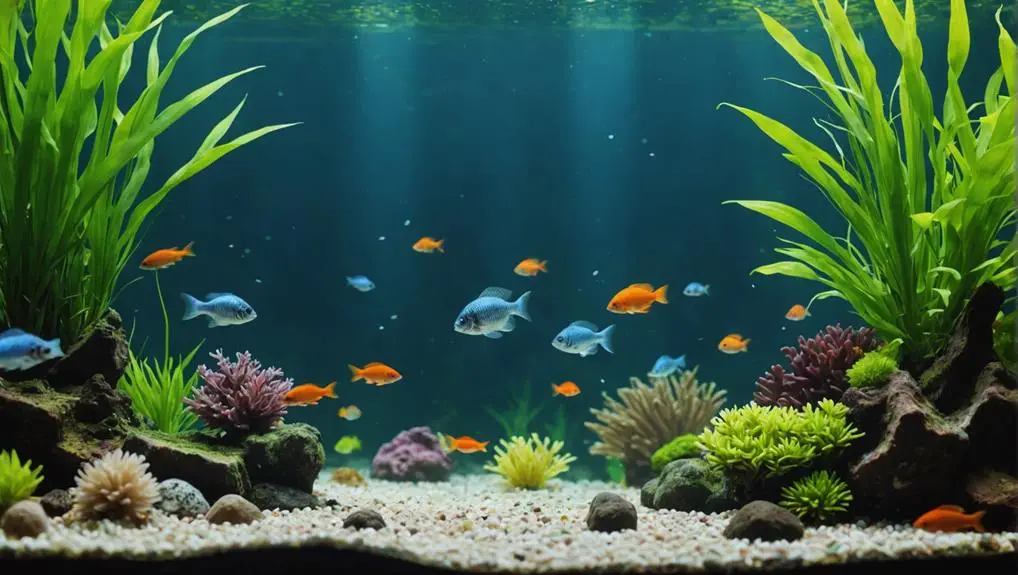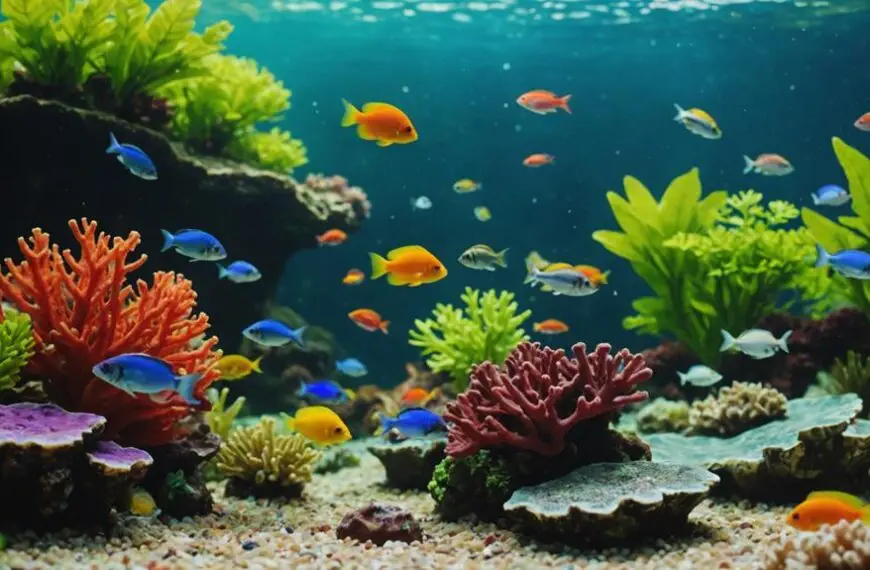Feeding your freshwater aquarium fish the right diet is key to their health and happiness. Start by knowing what types of fish you have—herbivorous, carnivorous, or omnivorous—as each has its own needs. Offer high-quality foods like algae wafers for plant lovers or shrimp for the meat eaters among them. Feed them once or twice a day, but keep it to what they can munch in just 2-3 minutes. Oh, and don't forget to remove any uneaten food to keep the tank clean! Stick around to discover more fabulous tips for happy, well-fed fish.
Contents
Understanding Fish Dietary Needs
Understanding the dietary needs of your freshwater fish is essential for their health and well-being. Just like us, different fish species have specific nutritional requirements that make them thrive.
You've got herbivorous fish, which need a plant-based diet full of greens, and carnivorous fish, who prefer protein-rich meals. Then there are omnivores, the adventurous eaters of the tank, enjoying both plants and animals. It's also important to consider the specific types of fish you have, as dietary needs vary by species.
Knowing what your fish need is key! Herbivores have longer digestive systems to break down those greens, while carnivores have shorter ones, designed to quickly process protein. This means that selecting the right food is significant not just for their taste buds but for their overall health too.
Don't forget the variety! Mixing flakes, pellets, and even frozen foods can cater to the dietary needs of your diverse aquatic family.
Remember, high-quality foods with whole ingredients are better than those packed with fillers. They help your fish grow strong while keeping your tank cleaner.
Selecting the Right Foods
When it comes to picking the right foods for your fish, knowing their specific dietary needs is key.
For example, dietary habits of common fish like guppies and cory catfish can vary significantly, requiring a mix of high-quality flakes and sinking pellets. Some fish are picky eaters, while others will devour anything that floats by.
Mixing up food types like flakes, pellets, and even frozen treats can keep everyone happy and healthy. Just remember, choosing the right size is crucial; you wouldn't want your tiny fish trying to tackle a giant wafer, right?
Species-Specific Dietary Needs
Choosing the right food for your freshwater aquarium fish is crucial to their health and well-being. You wouldn't want to serve your guests a meal they can't enjoy, right? Knowing the dietary needs of your fish species is the first step in making sure they thrive.
For instance, carnivorous fish need a high-protein diet, so think shrimp and bloodworms; they'll love you for it! On the other hand, herbivorous fish are all about the greens, requiring a diet rich in plant-based foods like spirulina and algae wafers. They definitely appreciate a salad bar!
Now, if you've got omnivorous fish, you've hit the jackpot! These little guys can eat it all, so a mix of both animal and plant sources keeps them happy and healthy. You can offer them flakes, pellets, and even some live or frozen treats.
Just remember to consider the size and shape of the food you choose—larger pellets can be a choking hazard for smaller fish, and nobody wants that drama in their tank. By selecting the right types of food, you're ensuring your fish enjoy a proper diet, leading to a vibrant, lively aquarium!
Food Types and Variations
How do you ensure your freshwater fish get the right nutrients? Selecting the right fish foods can make all the difference in their health and happiness. With so many food types available—like dry flakes, pellets, frozen options like shrimp and bloodworms, freeze-dried treats, and even live food—there's something for every fish's dietary needs.
Keep in mind that different types of fish have unique requirements. For example, herbivorous fish thrive on plant-based foods such as spirulina and veggies. On the other hand, carnivorous and omnivorous species enjoy a mix of animal proteins and plant matter. It's like preparing a gourmet meal for each of your aquatic pals!
Don't forget about the nutritional balance! Many fish benefit from a varied diet, so mixing different food types can enhance their overall health.
Also, consider the mouth size of your fish; smaller fish will need finer particles to prevent waste and ensure they actually eat the food. Specialty formulated fish foods often come packed with extra vitamins and minerals, giving your fish the best chance at a long, vibrant life.
Feeding Quantity Guidelines
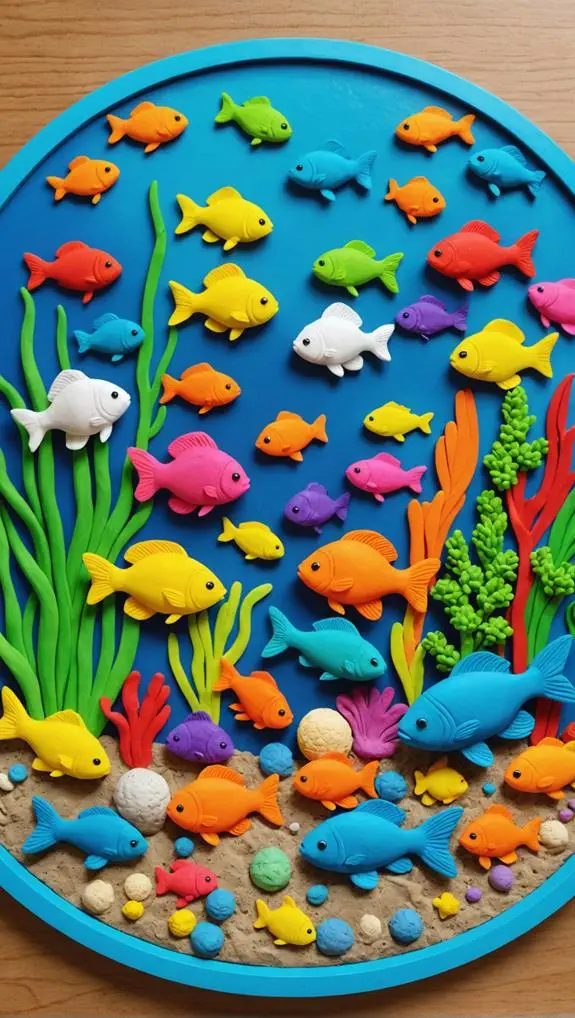
Determining the right feeding quantity for your freshwater aquarium fish is crucial for their health and well-being. You want to ensure your fish get the right amount of food without jeopardizing water quality. A good rule of thumb is to feed them what they can consume in 2-3 minutes. If you notice leftovers after five minutes, scoop up the uneaten food—it's a feast for bacteria otherwise!
Additionally, maintaining optimal water quality is essential for fish health; thus, monitoring feeding habits will help you achieve this proper feeding routines.
Pay attention to how often you feed your fish. Adult fish usually thrive on once-daily feedings, while young fish need three to four smaller meals to meet their growth needs. Observe their behavior during feeding; this'll help you gauge their appetite and adjust the amount of food accordingly.
When you're scattering food, think of it as a buffet for all your little feeders. Distributing the food evenly ensures that even the shy fish get their fair share without any waste. Remember, overfeeding can lead to health issues, so keeping an eye on the feeding quantity is key.
With these tips, you'll create a happy, healthy aquarium where your fish can thrive!
Recommended Feeding Frequency
When it comes to feeding your freshwater fish, timing is key! Most fish do best with one or two meals a day, but if you've got little ones in your tank, they might need three or four smaller snacks to help them grow big and strong.
And hey, don't forget to let them fast once or twice a week; it's like a mini spa day for their digestive system!
Daily Feeding Guidelines
Feeding your freshwater aquarium fish the right amount and at the right frequency is crucial for their health and well-being. Most fish need to be fed once or twice daily to meet their nutritional requirements effectively.
However, if you've got juvenile fish in your tank, you'll need to step up your game. These little guys typically require three to four small meals each day to support their rapid growth.
Now, if you have herbivorous fish, they appreciate several smaller feedings throughout the day. This way, they can nibble without overloading their delicate digestive systems.
Remember, it's not all about quantity; quality matters too. Keep an eye on how your fish behave after feeding. If they seem to be leaving food uneaten, it's a sign you might be overdoing it.
And don't forget about the occasional fasting! Giving your fish a break once or twice a week can help prevent obesity, especially in those eager feeders.
Fasting Benefits Explained
Regularly incorporating fasting into your fish's diet can significantly enhance their overall health. By fasting your fish once or twice a week, you help improve their digestive systems and prevent those pesky gastrointestinal issues that can arise from overfeeding. Think of it as a little break for their bellies!
Fasting also mimics the natural conditions of the wild, where food isn't always readily available. This promotes healthy eating habits and encourages your fish to forage, especially for juvenile fish still learning the ropes.
Plus, a little fasting can help manage their weight, keeping obesity at bay.
Don't forget, fasting plays a role in maintaining water quality in your aquarium. Less food means less waste, which reduces the risk of ammonia spikes—something every fish owner dreads!
While your fish are fasting, take the opportunity to observe them. Active and engaged fish are typically healthier, so if you notice any that seem listless, it could be a sign to check in on their health.
Signs of Overfeeding
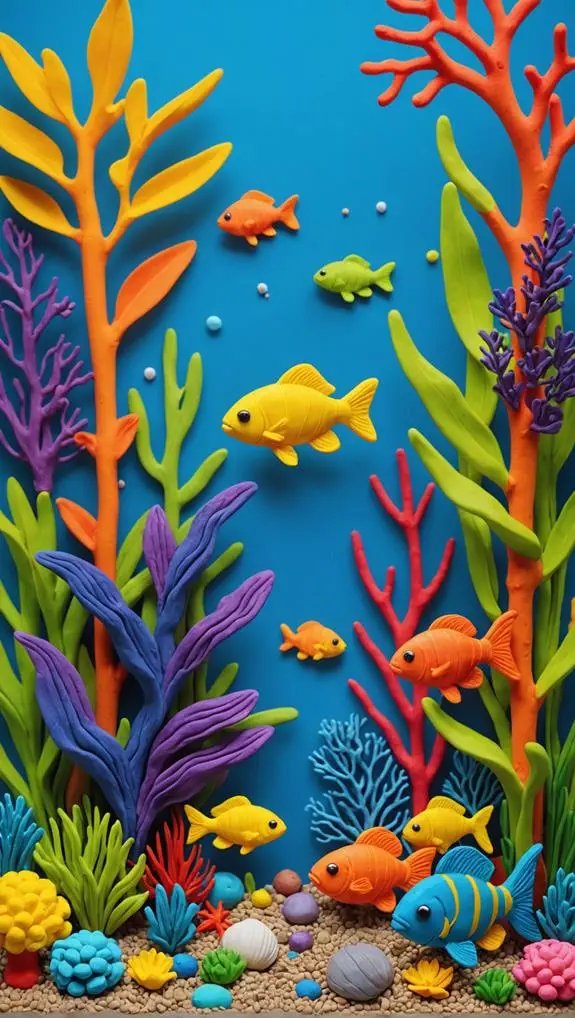
Overfeeding your freshwater aquarium fish can lead to several noticeable signs that indicate something's amiss in your tank. One of the first things you might spot is uneaten food lingering in the water after five minutes. If you see this, it's a clear signal that your fish aren't eating all the fish feed you're offering.
You might also notice cloudy water or a foul odor, which can stem from that uneaten food breaking down and releasing toxins. This degradation can clog your filter media, making it less efficient and harming your water quality.
Keep an eye on your ammonia levels, too; elevated ammonia or nitrite levels often point to overfeeding issues, as decaying food contributes to these harmful substances.
Lastly, watch for pesky algae growth. Overfeeding can lead to nutrient buildup, giving algae the party they didn't know they wanted!
Importance of Food Quality
Understanding the signs of overfeeding helps highlight another fundamental aspect of fish care: the quality of the food you provide.
When you choose high-quality fish food, you're investing in your fish's health and happiness. It's not just about filling their bellies; it's about giving them the right fuel for a balanced diet. High-quality foods often contain whole animal meals, offering far better nutritional value than those cheap fillers that do little more than take up space.
Think about it: a diet rich in quality protein sources like fish meal or krill meal can boost growth rates and enhance coloration.
Who wouldn't want their fish to be the most vibrant in the tank? Plus, you want to steer clear of chemical preservatives that could harm your aquatic pals over time.
Techniques for Effective Feeding
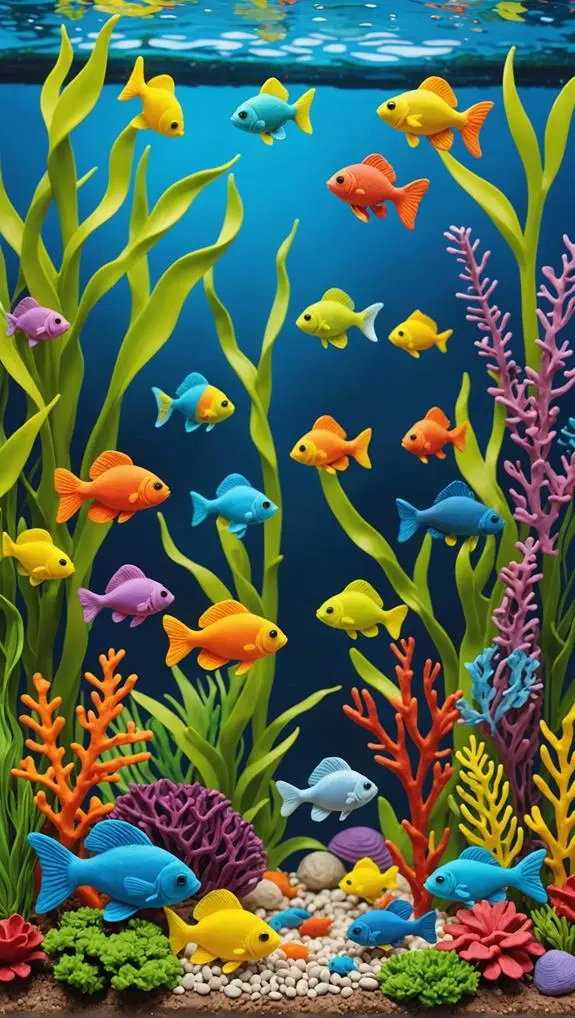
Feeding your aquarium fish effectively is crucial for their health and well-being. Start by establishing a consistent feeding schedule, offering food at the same times each day. This way, your fish will know when to expect their meals, reducing stress and creating a more relaxed environment.
Use varied techniques for effective feeding to cater to different types of fish. For example, surface feeding with flakes is great for those who love to swim up for a snack, while sinking pellets work wonders for bottom feeders. Keep an eye on food distribution during feeding sessions, ensuring every fish gets their fair share. If you notice some fish getting too competitive, adjust the food per feeding to promote harmony.
Consider using feeding clips for leafy greens and specialized feeding zones. This encourages natural foraging behaviors and helps keep your tank clean by cutting down on uneaten food.
Don't forget about the shy or nocturnal species! A little evening snack can make all the difference, so adjust lighting to help them feel comfortable.
With these techniques, your fish will thrive, and you'll enjoy the rewarding experience of serving them well!
Frequently Asked Questions
What Should I Feed My Freshwater Fish?
You should feed your freshwater fish a mix of commercial fish food, live food options, and vegetable supplements. Pay attention to their dietary needs, maintain a consistent feeding frequency, and ensure a nutritional balance for their health.
How Many Times a Day Should You Feed Freshwater Fish?
You should feed your freshwater fish once or twice daily, adjusting the feeding frequency based on their species. Consider pellet size, tank temperature, and water quality to support optimal fish digestion and natural feeding behavior.
How to Feed Every Fish in an Aquarium?
Feeding your fish is like crafting a culinary masterpiece. Use feeding techniques that cater to each species' nutritional needs, diversify their diets, and establish tank-specific feeding schedules to ensure every fish thrives happily and healthily.
How to Know if Aquarium Fish Are Hungry?
To know if your aquarium fish are hungry, observe their behavior for hunger signs, monitor feeding schedules, and ensure their nutritional needs are met. Watch for health indicators, as overfeeding can pose risks to their well-being.
Final Thoughts
In conclusion, giving your freshwater fish a fantastic feast is all about balance. By knowing their needs, selecting superior snacks, and sticking to smart serving sizes, you'll create a colorful, captivating aquarium. Remember, less is often more when it comes to feeding. So, keep an eye out for signs of overindulgence, and make mealtime meaningful! With the right approach, you'll help your finned friends flourish and frolic with joy in their watery world. Happy fishkeeping!

